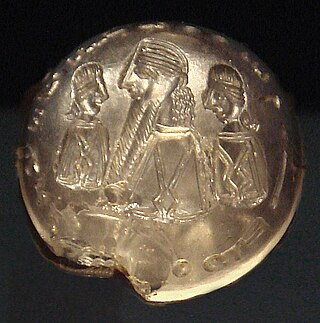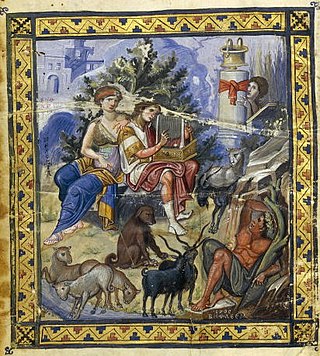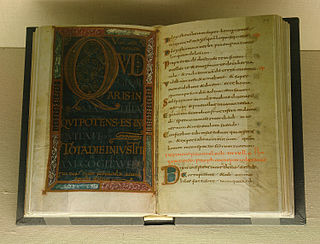Related Research Articles

Manichaeism is a former major world religion, founded in the 3rd century CE by the Parthian prophet Mani, in the Sasanian Empire.

The Book of Psalms, also known as the Psalms, or the Psalter, is the first book of the third section of the Hebrew Bible called Ketuvim ("Writings"), and a book of the Old Testament.

Avestan is an umbrella term for two Old Iranian languages, Old Avestan and Younger Avestan. They are known only from their conjoined use as the scriptural language of Zoroastrianism; the Avesta serves as their namesake. Both are early Eastern Iranian languages within the Indo-Iranian language branch of the Indo-European language family. Its immediate ancestor was the Proto-Iranian language, a sister language to the Proto-Indo-Aryan language, with both having developed from the earlier Proto-Indo-Iranian language; as such, Old Avestan is quite close in both grammar and lexicon to Vedic Sanskrit, the oldest preserved Indo-Aryan language.

A psalter is a volume containing the Book of Psalms, often with other devotional material bound in as well, such as a liturgical calendar and litany of the Saints. Until the emergence of the book of hours in the Late Middle Ages, psalters were the books most widely owned by wealthy lay persons. They were commonly used for learning to read. Many Psalters were richly illuminated, and they include some of the most spectacular surviving examples of medieval book art.
Biblical Aramaic is the form of Aramaic that is used in the books of Daniel and Ezra in the Hebrew Bible. It should not be confused with the Targums – Aramaic paraphrases, explanations and expansions of the Hebrew scriptures.
Middle Persian literature is the corpus of written works composed in Middle Persian, that is, the Middle Iranian dialect of Persia proper, the region in the south-western corner of the Iranian plateau. Middle Persian was the prestige dialect during the era of Sasanian dynasty. It is the largest source of Zoroastrian literature.
Frahang-ī Pahlavīg is the title of an anonymous dictionary of mostly Aramaic logograms with Middle Persian translations and transliterations. Its date is unknown.
Pahlavi may refer to:

The Avestan alphabet is a writing system developed during Iran's Sasanian era (226–651 CE) to render the Avestan language.

The Book of Arda Viraf is a Zoroastrian text written in Middle Persian. It contains about 8,800 words. It describes the dream-journey of a devout Zoroastrian through the next world. The text assumed its definitive form in the 9th-10th centuries after a series of redactions and it is probable that the story was an original product of 9th-10th century Pars.

Pahlavi is a particular, exclusively written form of various Middle Iranian languages. The essential characteristics of Pahlavi are:

The Manichaean script is an abjad-based writing system rooted in the Semitic family of alphabets and associated with the spread of Manichaeism from southwest to central Asia and beyond, beginning in the third century CE. It bears a sibling relationship to early forms of the Pahlavi scripts, both systems having developed from the Imperial Aramaic alphabet, in which the Achaemenid court rendered its particular, official dialect of Aramaic. Unlike Pahlavi, the Manichaean script reveals influences from the Sogdian alphabet, which in turn descends from the Syriac branch of Aramaic. The Manichaean script is so named because Manichaean texts attribute its design to Mani himself. Middle Persian is written with this alphabet.

Imperial Aramaic is a linguistic term, coined by modern scholars in order to designate a specific historical variety of Aramaic language. The term is polysemic, with two distinctive meanings, wider (sociolinguistic) and narrower (dialectological). Since most surviving examples of the language have been found in Egypt, the language is also referred to as Egyptian Aramaic.

Syriac is a dialect of Aramaic. Portions of the Old Testament were written in Aramaic and there are Aramaic phrases in the New Testament. Syriac translations of the New Testament were among the first and date from the 2nd century. The whole Bible was translated by the 5th century. Besides Syriac, there are Bible translations into other Aramaic dialects.

Bible translations in the Middle Ages went through several phases, all using the Vulgate. In the Early Middle Ages, they tended to be associated with royal or episcopal patronage, or with glosses on Latin texts; in the High Middle Ages with monasteries and universities; in the Late Middle Ages, with popular movements which caused, when the movement were associated with violence, official crackdowns of various kinds on vernacular scripture in Spain, England and France.
Psalter Pahlavi is a cursive abjad that was used for writing Middle Persian on paper; it is thus described as one of the Pahlavi scripts. It was written right to left, usually with spaces between words.
Bible translations into Persian have been made since the fourth or fifth century, although few early manuscripts survive. There are both Jewish and Christian translations from the Middle Ages. Complete translations of the Hebrew Bible and Greek New Testament from original languages were first made in the 19th century by Protestant missionaries.
Psalter Pahlavi is a Unicode block containing characters for writing Middle Persian. The script derives its name from the "Pahlavi Psalter", a 6th- or 7th-century translation of a Syriac book of psalms.
Portions of the Bible were translated into the Sogdian language in the 9th and 10th centuries. All surviving manuscripts are incomplete Christian liturgical texts, intended for reading on Sundays and holy days. It is unknown if a whole translation of any single book of the Bible was made, although the text known as C13 may be a fragment of a complete Gospel of Matthew. All but one text are written in Syriac script; only a few pages of the Book of Psalms written in Sogdian script are extant.

Maʿna, also known as Maʿna of Pars, Maʿna of Rev Ardashir or Maʿna of Shiraz, was a Persian Christian theologian, author and an East Syriac metropolitan bishop of Pars during the 5th and 6th centuries AD.
References
- ↑ Kenneth J. Thomas & Ali Asghar Aghbar (2015), p. 37–9.
- ↑ Whittingham, Martin (2020). A History of Muslim Views of the Bible: The First Four Centuries. De Gruyter. p. 12. ISBN 9783110335880.
- ↑ Kenneth J. Thomas & Fereydun Vahman, p. 209-213.
- Andreas, Friedrich Carl (1910). "Bruchstücke einer Pehlewi-Übersetzung der Psalmen aus der Sassanidenzeit". Sitzungsberichte der Königlich Preussischen Akademie der Wissenschaft, Philosophisch-historische Klasse. XLI (4). Berlin: PAW: 869–872.
- Gignoux, Philippe (2002). "Pahlavi Psalter". Encyclopedia Iranica . Costa Mesa: Mazda.
- Kenneth J. Thomas; Ali Asghar Aghbar (2015). A Restless Search: A History of Persian Translations of the Bible. ISBN 9781944092023.
- Kenneth J. Thomas; Fereydun Vahman. "BIBLE vii. Persian Translations of the Bible". Encyclopaedia Iranica. Vol. IV/2. pp. 209–213.